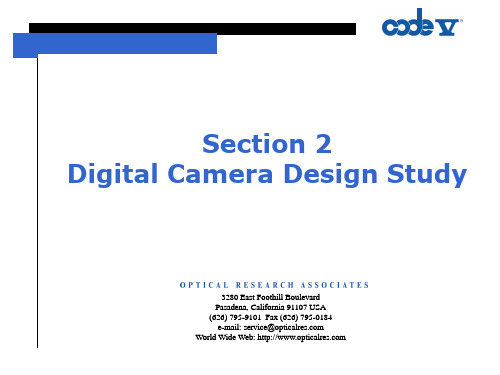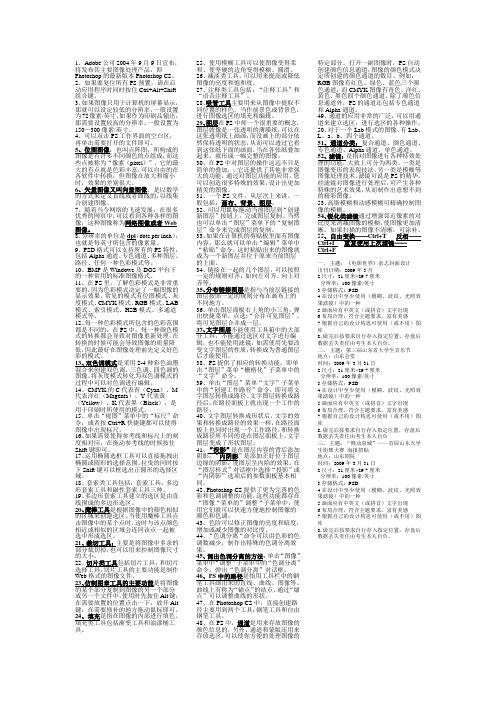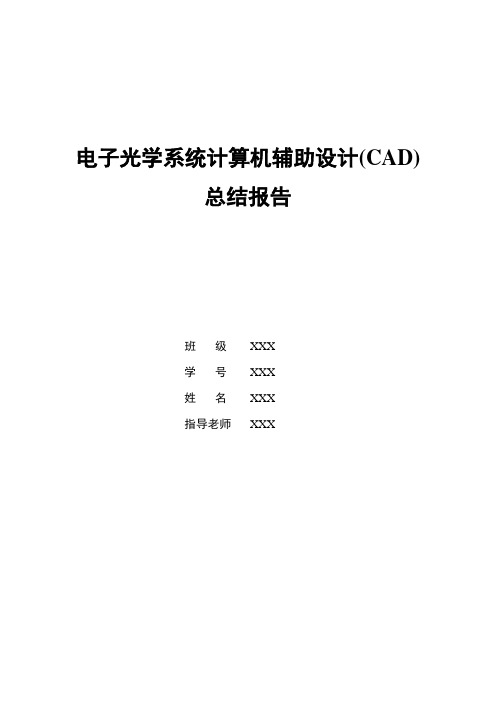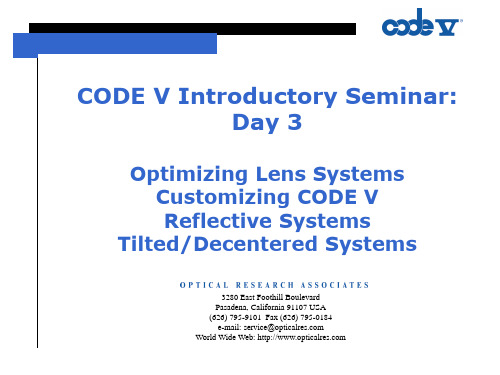【资料】计算机辅助光学设计-code-v-s2汇编
(整理)各种光学设计软件介绍-学习光学必备-peter.

光学设计软件介绍ZEMAX是美国焦点软件公司所发展出的光学设计软件,可做光学组件设计与照明系统的照度分析,也可建立反射,折射,绕射等光学模型,并结合优化,公差等分析功能,是套可以运算Sequential及Non-Sequential的软件。
版本等级有SE:标准版,XE:完整版,EE:专业版(可运算Non-Sequential),是将实际光学系统的设计概念、优化、分析、公差以及报表集成在一起的一套综合性的光学设计仿真软件。
ZEMAX的主要特色:分析:提供多功能的分析图形,对话窗式的参数选择,方便分析,且可将分析图形存成图文件,例如:*.BMP, *.JPG...等,也可存成文字文件*.txt;优化:表栏式merit function参数输入,对话窗式预设merit function参数,方便使用者定义,且多种优化方式供使用者使用;公差分析:表栏式Tolerance参数输入和对话窗式预设Tolerance参数,方便使用者定义;报表输出:多种图形报表输出,可将结果存成图文件及文字文件。
CODE V是Optical Research Associates推出的大型光学设计软件,功能非常强大,价格相当昂贵CODE V提供了用户可能用到的各种像质分析手段。
除了常用的三级像差、垂轴像差、波像差、点列图、点扩展函数、光学传递函数外,软件中还包括了五级像差系数、高斯光束追迹、衍射光束传播、能量分布曲线、部分相干照明、偏振影响分析、透过率计算、一维物体成像模拟等多种独有的分析计算功能。
是世界上应用的最广泛的光学设计和分析软件,近三十多年来,Code V进行了一系列的改进和创新,包括:变焦结构优化和分析;环境热量分析;MTF和RMS波阵面基础公差分析;用户自定义优化;干涉和光学校正、准直;非连续建模;矢量衍射计算包括了偏振;全球综合优化光学设计方法。
CODE V是美国著名的Optical Research Associates(ORA®)公司研制的具有国际领先水平的大型光学工程软件。
计算机辅助光学设计_code_V_S2

• In this case, we will use the patent database, making use of the “filter” capability to narrow down the search based on the required specifications
Introduction to CODE V Training, Fall 2003, Slide 2-‹#›
Run the New Lens Wizard
• Choose the File > New menu to launch the NLW
– Click Next> to clear the Welcome Screen – Click the Patent Lens button, then click Next>
>90% (central) >30% (central) >85% (outer) >25% (outer)
Objective Lens
e. Focus f. Focal length g. Geometric Distortion h. f/number i. Sharpness
Low freq., 17 lp/mm High freq., 51 lp/mm
• Click the Next> button
Note that each patent lens file includes a lens drawing, and this one shows three defined field angles
Introduction to CODE V Training, Fall 2003, Slide 2-‹#›
计算机辅助设计二

1、Adobe公司2004年9月9日宣布,将发布其主要图像处理产品,即Photoshop的最新版本Photoshop CS。
2、如果要复位所有PS预置,请在启动应用程序时同时按住Ctrl+Alt+Shif t 组合键。
3、如果图像只用于计算机的屏幕显示,那就可以设定较低的分辨率,一般设置为72像素/英寸。
如果作为印刷品输出,那需要设置较高的分辨率,一般设置为150—300像素/英寸。
4、可以双击PS工作界面的空白区,再单击需要打开的文件即可。
5、位图图像:也叫点阵图,所构成的图像是有许多不同颜色的点组成,而这些点被称为“像素(pixel)”。
它的最大的有点就是色彩丰富,可以自由的在各软件中转换,但图像在放大和缩小时,效果的差别很大。
6、矢量图像又叫向量图像,是以数学的方式来定义直线或者曲线的,以线集合创建图像。
7、随着当今网络的飞速发展,在很多优秀的网页中,可以看到各种各样的图像,这种图像称为网络图像或者Web 图像。
8、分辨率的单位是dpi(dots per inch),也就是每英寸所包含的像素量。
9、PSD格式可以支持所有的PS特性,包括Alpha通道、专色通道、多种图层、路径、任何一种色彩模式等。
10、BMP是Windows及DO S平台下的一种常用的标准图像格式。
11、在PS里,了解色彩模式是非常重要的,因为色彩模式决定了一幅图像的显示效果。
常见的模式有位图模式、灰度模式、CMYK模式、RG B模式、LAB 模式、索引模式、HSB模式、多通道模式等。
12、每一种色彩模式所包含的色彩范围都是不同的,在PS中,每一种颜色模式的转换都会导致对图像重新处理,在转换的时候可能会导致图像的质量降低,因此最好在图像处理前先定义好色彩的模式。
13、双色调模式是采用2-4种彩色油墨三色调、四色调的图像。
将灰度模式转化为双色调模式的过程中可以对色调进行编辑。
14、CMYK的C代表青(Cyan)、M 代表洋红(Magenta)、Y代表黄(Yellow)、K代表黑(Black),是用于印刷时所使用的模式。
电子光学系统计算机辅助设计(CAD)总结报告

电子光学系统计算机辅助设计(CAD)总结报告班级XXX学号XXX姓名XXX指导老师XXX摘要本课程设计以C语言为编程工具,综合运用《光电成像原理与技术》课程中有关的原理与知识,比如电场三大定理、超张弛连续迭代算法、拉格朗日插值算法等,使用计算机辅助设计将光电成像器件——像增强器中电子光学系统中各点的电位分布等计算、模拟出来。
所编写的程序可以在给定像管参数和电极电位的情况下,计算圆柱形像管内任意一点的电位大小,并绘制出像管内的等势线;拉格朗日插值得到对称轴上任一点的电位值。
关键词:电子光学系统;连续超张弛迭代;拉格朗日插值;电位叠加定理AbstractThis course is designed with C language programming tools,integrated use the principles and knowledge of "optical imaging theory and technology" course. Such as electric three theorems, super relaxation continuous iterative algorithm, and Lagrange interpolation algorithm. Using computer-aided design, we calculate and simulate the potential distribution of optoelectronic imaging device, image intensifier, in electron optical system at various points. In case the image tube parameters and electrode potential are known, the program written can get the potential of every point in the image tube, and plot equipotential lines inside the image tube. It can also get the potential of every point on the axis of symmetry by Lagrange interpolation.Key words: electron optical system; SOR; Lagrange interpolation; electric potential superposition theory目录一、前言 (1)二、理论基础 (1)2.1 有限差分法、SOR法以及等位点扫描 (1)2.2 扫描等位线 (3)三、程序设计思想 (3)四、程序主要变量与数组名 (4)五、程序流程框图 (5)六、使用说明 (6)七、误差分析 (7)7.1减少截断误差的方法: (7)7.2 减小残差的方法 (7)八、数据处理 (7)九、结果讨论 (10)十、致谢 (10)十一、参考文献 (11)附录一程序代码 (12)附录二输入数据 (37)附录三输出数据 (38)一、前言通常,电子光学系统的计算机辅助设计方法可以用来解决以下问题:1.计算系统的电场和磁场分布,包括旋转对称聚焦场、偏转场等;2.计算电子在电磁场中运动的轨迹;3.计算成像器件电子光学系统的成像参量(成像系统的像面位置、放大率 等)和偏转系统的偏转灵敏度等;4.计算系统的像差,包括各级几何像差(球差、彗差、场曲、像散、畸变 等)和色差,阴极透镜的近轴像差,偏转系统的偏转像差等;5.计算电子光学系统的像质评定指标——电子光学鉴别力和传递函数等。
[整理版]CODEV光学设计软件简介
![[整理版]CODEV光学设计软件简介](https://img.taocdn.com/s3/m/9bd49b9f690203d8ce2f0066f5335a8102d26618.png)
CODE V光学设计软件简介!CODE V是一个光学系统设计和分析优化软件,广泛使用于照相设备、摄影机和医疗器具等,功能强大使用简单灵活。
[attachment=136]CODE V是美国著名的Optical Research Associates(ORA®)公司研制的具有国际领先水平的大型光学工程软件。
自1963年起,该公司属下数十名工程技术人员已在CODE V程序的研制中投入了40余年的心血,使其成为世界上分析功能最全、优化功能最强的光学软件,为各国政府及军方研究部门、著名大学和各大光学公司广泛采用。
一. 包罗万象的适用范围CODE V可以分析优化各种非对称非常规复杂光学系统。
这类系统可带有三维偏心和/或倾斜的元件;各类特殊光学面如衍射光栅、全息或二元光学面、复杂非球面、以及用户自己定义的面型;梯度折射率材料和阵列透镜等等。
程序的非顺序面光线追迹功能可以方便地处理屋脊棱镜、角反射镜、导光管、光纤、谐振腔等具有特殊光路的元件;而其多重结构的概念则包括了常规变焦镜头,带有可换元件、可逆元件的系统,扫描系统和多个物像共轭的系统。
40多年来,世界各地的用户已成功地利用CODE V设计研制了大量照相镜头、显微物镜、光谱仪器、空间光学系统、激光扫描系统、全息平显系统、红外成像系统、紫外光刻系统等等,举不胜举。
近几年内,CODE V软件又被广泛地应用于光电子和光通讯系统的设计和分析。
[attachment=137]图1. 带有非顺序面的系统及梯度折射率元件示例二. 空前强大的自动设计能力光学设计的第一步是要为系统确定合理的初始结构。
为此CODE V提供了独有的“镜头魔棒”功能,用户只需输入所要设计的系统的使用波段、相对孔径、视场、变倍比等参数,软件即可从自带的专利库中找出对应的结构以供选择。
CODE V软件中优化计算的评价函数可以是系统的垂轴像差、波像差或是用户定义的其它指标,也可以直接对指定空间频率上的传递函数值进行优化。
计算机辅助光学设计usst本科课件

指导学生进行创新性光学系统设计,包括概念提出、结构设计、性 能分析等步骤,帮助学生掌握从理论到实践的设计过程。
设计评价
对学生的设计进行综合评价,包括设计的创新性、实用性、可行性 等方面,并给出改进意见和建议。
THANKS FOR WATCHING
感谢您的观看
总结案例中的设计经验、技巧和教训, 引导学生思考如何将这些经验应用到 自己的设计中。
案例分析
对每个案例进行深入分析,包括系统 结构、光学性能、像质评价等方面, 帮助学生理解光学系统设计的原理和 技巧。
计算机辅助光学设计软件操作实践
软件介绍
介绍常用的计算机辅助光学设计软件,如Zemax、Code V等,以 及它们在光学设计中的应用。
利用计算机辅助光学设计软件,对设 计方案进行模拟和分析,通过优化算 法对设计方案进行迭代优化。
评估性能
对优化后的光学系统进行性能评估, 包括像差、透过率、分辨率等性能指 标的评估。
生成设计图纸
根据最终的设计方案,生成详细的光 学元件设计图纸,包括元件的形状、 尺寸、材料等参数。
03 光学系统设计
光学系统设计的基本原则
摄影镜头
摄影镜头是光学设计最 常见的应用领域之一, 涉及各种相机镜头、电
影镜头等。
显微镜
显微镜是光学设计在生 物学、医学和工业领域 的重要应用,用于观察
微小物体。
望远镜
光学设计在天文观测中 发挥着关键作用,用于 制造高性能的天文望远
镜。
照明系统
光学设计在照明领域的 应用包括LED照明、投 影仪和照明设备的设计。
光学设计的基本概透镜系统中的传播路径,
以优化成像质量。
像差校正
像差是指透镜系统对不同波长 光线的畸变程度,像差校正是 指减小这些畸变以提高成像质 量。
计算机辅助光学设计(第一章)

图1.8为扩展光源在一个曲线段上的反射。图中R为 扩展光源半径,P(x,y)为边界光线在曲面上的入射点, (x,y)为光源上点的坐标,其切线即为相应于点P(x,y)的光 源的一条边界光线。图中用实线表示,另一条边界光线 用虚线表示,r为光源中心到此入射点的距离dr为入射 点处曲线的切向量,通过控制曲线段的参数可令实线表 示的边界光线入射到目标位置点Q处
由式可得,短焦距的凸透镜更加有效提高能 量收集率。而在成像光学中,具有相同口径的透 镜,短焦距透镜的曲率大于长焦距的透镜,由相 差理论,前者的成像质量不如后者。光斑在焦平 面上有一定的弥散,降低了系统的光能利用率。 非成像光学系统不再考虑成像光学中的像差理论 和成像质量,而是把光能利用率作为系统的评价 标准,更适用于以提高光能利用率为主要目标的 照明系统。
现有非成像系统如下图所示入光线方向为L, 光线输出处的橫截面积为A’,输出角为∑’,假设光学系 统无反射、折射、吸收等能量损失,根据光学扩展量有: sin2∑ A = sin2∑’A’
根据输入输出的面积和角度的关系,定义 能量收集比率C为:
1.LED小型投影仪
下图为方棒照明系统。由图知:光线在方棒内壁进行 了3次左右反射之后,在方棒出口处形成了一矩形的均匀 光斑。若在方棒出口处与显示芯片之间设计一组光学透 镜,将方棒出口处的光斑成像到显示芯片上,实现均匀 照明。
方棒照明系统
2.景观照明:包括商业街、步行街道路照明、商业建筑 物户外照明、广告招牌照明等。 3.汽车前车灯:超高亮度LED可以做成刹车灯、方向灯、 尾灯,也可用仪表照明和车内照明,它 在耐震动、省电、长寿命方面比白炽灯 具有明显优势。 4.LED手电筒:传统的灯泡手电的优点是光谱连续、光 色舒适,但在低功率下效率较低,在电 量不足时灯会变黄变暗。而LED灯具有 远射性能,减少光散射,令聚焦更准确, 使光束平行射出,使光线更柔和。
计算机辅助图形设计【仅供参考】

计算机辅助图形设计复习资料1.位图图像又称为点阵图像,是由像素组成的可识别的图像。
2.一个完整的Photoshop CS2 的工作界面有菜单命令、工具选项栏、调色窗、工具箱、调板、操作文件共同构成。
3.Photoshop中最基础的工作流程:新建文件、打开文件、浏览图像文件以及保存文件。
4.用于彩色印刷的图像分辨率应达到300像素/英寸;用于报刊、杂志等一般印刷的图像分辨率应达到150像素/英寸;用于网页、屏幕浏览的图像分辨力可视之为72像素/英寸。
5.Ctrl+N是新建文件的快捷键。
6.JPEG的格式选项有:基线、基线已优化、连续。
7.TIFF是应用广泛的图像文件格式之一。
8.完成图像文件的编辑后,按快捷键Ctrl+W即可快速的关闭当前操作文件。
9.扫描仪主要可以分为平板扫描仪、幻灯牌扫描仪、滚筒式扫描仪。
10.Photoshop CS2首选项中主要包括常规、文件处理、显示与光标、透明度与色域、单位域标尺、参考线、网络域切片、PLUG-ns 域暂存盘、内存域图像高速缓存、文字。
11.Phooshop采用重定图像像素的最佳方法是“二次立方”。
12.在使用其他工具时,需要是打不过调整图像的现实内容,可以按住“空格”键暂时切换到抓手工具。
13.按住Tab键可以隐藏屏幕中的工具箱和所有调板。
14.Photoshop CS2中有标准屏幕模式、带有菜单栏的全屏模式以及全屏模式三中屏幕模式。
15.光的三原色包括:红、绿、蓝。
16.Photoshop 默认的色彩模式是RGB模式,但用于色彩印刷的图像色彩模式去必须使用CMYK模式。
17.“位图”模式的图像也叫黑白图像或1位图像。
18.填充前景色可以用快捷键Alt+Delete,填充背景色可以使用Ctrl+Delete。
19.选区可分为几何形状选区和任意形状选区。
20.路径类型包括直线型路径、曲线型路径和混合型路径。
21.PhotoshopCS2 中具有两种文字类型点文字和段落文字。
计算机辅助光学设计 code V.共97页

•
26、我们像鹰一样,生来就是自由的 ,但是 为了生 存,我 们不得 不为自 己编织 一个笼 子,然 后把自 己关在 里面。 ——博 莱索
•
27、法律如果不讲道理,即使延续时 间再长 ,也还 是没有 制约力 的。— —爱·科 克
•
28、好法律是由坏风俗创造出来的。 ——马能够接受法律支配的人类 的状态 中,哪 里没有 法律, 那里就 没有自 由。— —洛克
•
30、风俗可以造就法律,也可以废除 法律。 ——塞·约翰逊
谢谢!
51、 天 下 之 事 常成 于困约 ,而败 于奢靡 。——陆 游 52、 生 命 不 等 于是呼 吸,生 命是活 动。——卢 梭
53、 伟 大 的 事 业,需 要决心 ,能力 ,组织 和责任 感。 ——易 卜 生 54、 唯 书 籍 不 朽。——乔 特
55、 为 中 华 之 崛起而 读书。 ——周 恩来
光学计算机辅助设计报告

光学设计辅助报告姓名:张雨辰学号:1011100139光学计算机辅助设计报告内容一:已知参数双胶合望远物镜的像质评价1)像质评价的意义:任何一个光学系统不管用于何处,其作用都是把目标发出的光按仪器工作原理的要求改变它们的传播方向和位置,送入仪器的接收器,从而获得目标的各种信息,包括目标的几何形状、能量强弱等。
因此,对光学系统成像性能的要求主要有两个方面:第一方面是光学特性,包括焦距、物距、像距、放大率、入瞳位置、入瞳距离等;第二方面是成像质量,光学系统所成的像应该足够清晰,并且物像相似,变形要小。
第一方面的内容即满足光学特性方面的要求属于应用光学的讨论范畴,第二方面的内容即满足成像质量方面的要求,则属于光学设计的研究内容。
从物理光学或波动光学的角度出发,光是波长在400~760nm的电磁波,光的传播是一个波动问题。
一个理想的光学系统应能使一个点物发出的球面波通过光学系统后仍然是一个球面波,从而理想地聚交于一点。
但是实际上任何一个实际光学系统都不可能理想成像。
所谓像差就是光学系统所成的实际像与理想像之间的差异。
由于一个光学系统不可能理想成像,因此就存在一个光学系统成像质量优劣的评价问题,从不同的角度出发会得出不同的像质评价指标。
从物理光学出发,推导出几何像差等像质评价指标。
有了像质评价的方法和指标,设计人员在设计阶段,即在制造出实际的光学系统之前就能预先确定其成像质量的优劣,光学设计的任务就是根据对光学系统的光学特性和成像质量两方面的要求来确定系统的结构参数。
2)像质评价的方法与Zemax实现:对于像质评价有两个阶段:1 设计完成后,加工前,对成像情况进行模拟仿真;2 加工装配后,批量生产前,要严格检测实际成像效果。
当前我们所作的工作就是对第一阶段进行实际讨论。
对于像质评价的方法有两种:1 不考虑衍射:光路追迹法(点列图,像差曲线);2 考虑衍射:绘制成像波面,光学传递函数等;有:瑞利判断:几何像差曲线进行图形积分得到波像差;中心点亮度(斯托列尔准则):成像衍射斑的中心亮度和不存在像差时衍射斑的中心亮度之比S.D来表示成像质量;分辨率:反映光学系统分辨物体细节的能力,可以评价成像质量;点列图:由一点发出的许多光线经光学系统后,因像差使其与像面的交点不再集中于同一点,而形成了一个散布在一定范围的弥散图形,称为点列图;传递函数:一定空间频率下像的对比度与物的对比度之比。
计算机辅助光学设计_code_V_S6

What is an Error Function?
• A single positive number that represents the quality of the optical system
• Structured such that smaller values are better than larger values
• Step 2 - In AUTO, select the error function type on the Error Function Definitions and Controls tab
– The default CODE V error function is usually a good start, but you may wish to make minor modifications, such as number of rays
this) – Aperture weighting (default tries for tight core with some allowed flare)
Introduction to CODE V Training, Fall 2003, Slide 6-6
Reducing the Error Function
• Takes significantly longer than local optimization • Not covered further in this seminar
Introduction to CODE V Training, Fall 2003, Slide 6-7
How CODE V Handles Constraints
• Step 3 - Specify constraints (in addition to default general constraints)
- 1、下载文档前请自行甄别文档内容的完整性,平台不提供额外的编辑、内容补充、找答案等附加服务。
- 2、"仅部分预览"的文档,不可在线预览部分如存在完整性等问题,可反馈申请退款(可完整预览的文档不适用该条件!)。
- 3、如文档侵犯您的权益,请联系客服反馈,我们会尽快为您处理(人工客服工作时间:9:00-18:30)。
f. Focal length
Fixed, 6.0 mm
g. Geometric Distortion
<4%
h. f/number
Fixed aperture, f/3.5
i. Sharpness
MTF through focus range (central is inner 3 mmof CCD)
Command Line
Introduction to CODE V Training, Fall 2003, Slide 2-‹#›
Plot Window
Tabbed Output WiOptions
• CODE V has two major levels, LDM and Options
– Work with system data, basic solves, lens drawings, surface data, scaling, MTF, and more
– Use Optimization to improve the lens – Perform Tolerance Analysis
• Surface data is accessed from the LDM spreadsheet and from the Lens > Surface Properties menu
– LDM spreadsheet displays basic data – Surface Properties dialog shows all data for a surface
– Each option creates its own tabbed output window (TOW) – Option input can be modified or re-run from its TOW
Introduction to CODE V Training, Fall 2003, Slide 2-‹#›
计算机辅助光学设计-code-VS2
Introduction to CODE V Training, Fall 2003, Slide 2-‹#›
Title Bar
Interface Elements
Navigation Window Menu Bar
Toolbar
LDM Spreadsheet
Command Window
• The LDM is operated from menus, tool bars, and dialog boxes (or from the command line)
• Options are launched from menus and controlled from tabbed dialog boxes
Digital Camera Specs
• Small number of elements (1-3) made fromcommon glasses or plastics
• Image sensor (baseline is Agilent FDCS-2020)
a. Type
CMOS
b. Resolution
• What you will learn:
– Use the New Lens Wizard to select a patent lens as a starting point for a new design
– Change the System Data as needed for the new application
Introduction to CODE V Training, Fall 2003, Slide 2-‹#›
Digital Camera Design Study
• This section is based on the Digital Camera Objective example in the CODE V Introductory User’s Guide
• A similar problem will be posed as a workshop at the end of this section (solution script in the Appendix)
Introduction to CODE V Training, Fall 2003, Slide 2-‹#›
640 x 480 effective pixels
c. Pixel size
7.4 x 7.4 microns
d. Sensitive area
3.55 x 4.74 mm (full diagonal 6 mm)
• Objective Lens
e. Focus
Fixed, depth of field 750 mm (2.5 ft.) to infinity
System Data and Surface Data
• LDM data is divided into two major categories
– System Data specifies overall properties such as f/number and wavelengths
– LDM is Lens Data Manager, where lens data is defined and modified
– Options are special calculations requiring multiple inputs, e.g., spot diagram, MTF, Automatic Design
– Surface Data specifies any data that changes with surface number, from thickness to decenters to tolerances
• System Data is accessed through the Lens > System data menu, which displays a multi-tabbed dialog box
